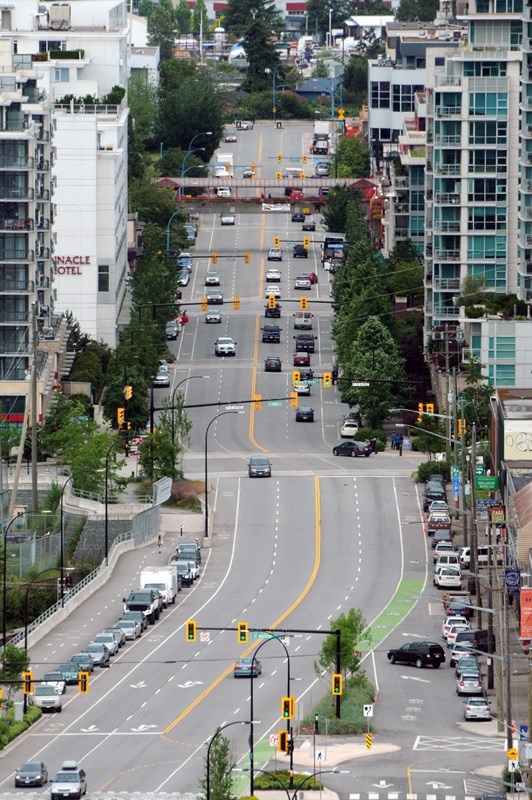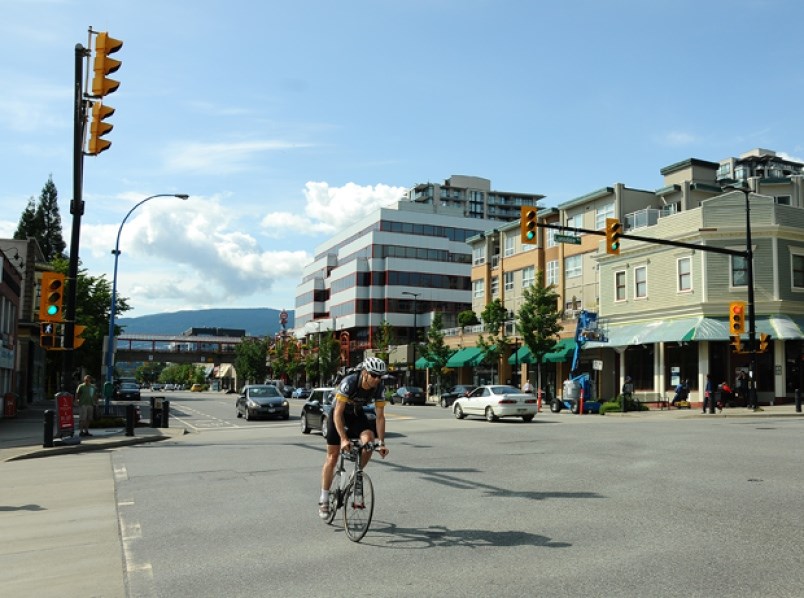Recently City of North Vancouver Council voted to make Esplanade a “Complete Street.”
So what does that mean? The staff presentation emphasized safety for all users: people cycling, walking, driving cars, delivery van drivers, heavy vehicle and bus operators. Staff were upbeat about this corridor’s possibilities to be safer and more appealing as a destination, creating a more lively street experience for both residents and visitors.
Envision safe, accessible crosswalks. Separated cycling infrastructure. Wide, uncluttered sidewalks with awnings above for rain protection. People shopping on foot, walking the dog, enjoying an ice cream on a bench. Trees. Good lighting and a great public realm, contributing to a sense of place and well-being.
Then a train of semi-trucks thunders by.
There are probably many things we can do to improve the Esplanade experience. But, there’s one thing that won’t change. Those big trucks working construction sites, delivering containers, or supplying grocery stores need space too.
As a person who uses a bicycle for transportation, I support the complete street initiative. Currently, you could not pay me to ride alongside the parked cars escorted by an 18-wheeler rumbling in the travel lane next to me. We can readily achieve safety for more vulnerable road users by separating vehicles from pedestrians and people riding from pedestrians and vehicles. But can we make Esplanade a friendly place to be outdoors with semi-trailers and heavy-duty construction trucks dieseling through? I have doubts.

You can’t say the council didn’t discuss the elephant in the room. They did. The mayor was very clear that trucks will be staying on Esplanade. It’s not her preference I am sure. But it is not a local choice. The road is part of TransLink’s Major Roadway Network, supporting regional people and goods’ movement. According to TransLink, “the network includes major arterial roads that carry commuter, transit, and truck traffic. The Major Road Network connects the provincial highway system with the local road network, and some corridors also serve cyclists and pedestrians.”
Also, TransLink provides money to these routes. Ironically, part of the Esplanade complete streets project funding will probably come from TransLink because it is part of the MRN.
If we must retain the trucks, how do we create “vibrancy” and a pleasant public realm? The livability factor is important in this increasingly residential neighbourhood. There are probably more voters in LoLo thinking, “wouldn’t it be great if there were a lower speed limit and no trucks allowed” than those who think “Esplanade should be a freeway.”
How could we move trucks off the Esplanade corridor? I can think of three ways.
For one, we could just bury the problem. The train goes underground from St. Andrews to Chesterfield. Why not through-traffic trucks and other vehicles? A tunnel could take most traffic, let alone trucks, off Esplanade from Forbes east to the Low Level Road. Local-traffic-only lanes could consist of one lane each way, allowing for goods delivery and commercial access.
Tunnels are expensive, though. The cost would simply not be on the same scale as buying new street furniture and putting in separated bike lanes (an estimated $5-million). Not to mention working around all those buried utilities. But you want vibrancy and improved public realm? That’s the way to do it. Plus, we could call it the Splunnel.
A cheaper variation would be to twin the blocks from Forbes to the Low Level Road vertically. Heavy truck and through traffic sails overhead on stilts. Local traffic stays at grade. Like the Splunnel, this solution increases public realm below the second level. Work out sound barriers, hang lights and heaters below the raised truck deck to create a covered winter space for more craft breweries and parks. Now that’s vibrant. And COVID-friendly. However, I’m not convinced that people in third-floor apartments would love this plan.
The cheapest and most obvious solution is to make all heavy vehicles take Highway 1 and designate a couple of additional north/south connectors to allow access to commercial locations, the port and industrial areas. Trucks moving through the entire distance from Horseshoe Bay to Ironworkers Memorial Second Narrows Crossing could just use Highway 1 unless they need to drop down to a destination below.
There are multiple restrictions in the downhill direction in West Vancouver, but there is no port and no industrial area so most heavy trucks would be construction-related and far fewer in number. As a result, heavy vehicles can travel on Marine Drive and it’s not a nightmare.
In North Vancouver, Capilano Road is already MRN-designated, but the Highway interchange might need reconfiguring to accommodate large trucks. Lonsdale is also a member of the MRN club and is a designated truck route. Brooksbank is not part of the MRN – Mountain Highway gets that designation. But Brooksbank is a designated truck route that the new Highway 1 off-ramp makes accessible. Adding a truck route down Westview, Larson and Fell would make this idea more feasible.
Esplanade and the Low Level Road combined with 1st Street to the west were originally conceived as a thoroughfare. But the fabulously successful development of Lower Lonsdale has placed thousands of residents right next to it. There are now seven lights from Semisch Avenue to St. Georges. Hardly an expressway. Making Esplanade a complete street is a laudable goal. Now is not the time to keep on trucking.
Heather Drugge is a sustainable transportation advocate who has used her bike for transportation for more than 20 years. She’s looking at getting an e-bike and maybe a jetpack next. [email protected]



